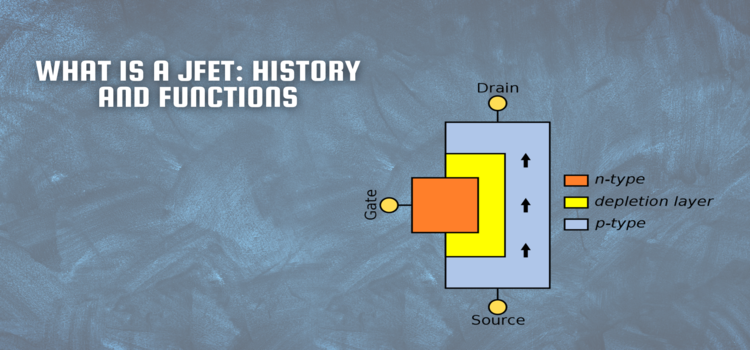The junction-gate field-effect transistor (JFET) is a basic type of field-effect transistor that is easy to understand, similarly to a MESFET. JFETs are semiconductor devices with three terminals that can function as switches or resistors that are controlled electronically, or they can be used to construct amplifiers.
JFETs differ from bipolar junction transistors in that they are controlled solely by voltage and do not require a biasing current. An electric charge moves through a semiconducting channel between the source and drain terminals. When a reverse bias voltage is applied to the gate terminal, the channel is constricted, causing the electric current to be obstructed or completely turned off. Typically, a JFET conducts when there is no voltage between its gate and source terminals. However, if a potential difference of the correct polarity is applied between the gate and source terminals, the JFET will become more resistant to current flow, resulting in less current flowing through the channel between the source and drain terminals.
JFETs are electronic devices that are commonly known as depletion-mode devices. This is because they operate based on the principle of a depletion region, which is an area that lacks majority charge carriers. In order for current to flow through a JFET, the depletion region must be closed.
JFETs can have either an n-type or p-type channel. In an n-type JFET, if the voltage applied to the gate is negative compared to the source, the current will be reduced. Similarly, in a p-type JFET, if the voltage applied to the gate is positive compared to the source, the current will also be reduced. Due to the fact that a JFET in a common source or common drain configuration has a high input impedance (sometimes on the order of 1010 ohms), it draws very little current from circuits used as input to the gate.
Julius Lilienfeld patented a series of FET-like devices in the 1920s and 1930s, but it took several decades of advances in materials science and fabrication technology before FETs could actually be manufactured. In 1945, Heinrich Welker patented the JFET, but it wasn't until 1953 that a practical JFET was made by George C. Dacey and Ian M. Ross, following Shockley's theoretical treatment on JFET in 1952. Japanese engineers Jun-ichi Nishizawa and Y. Watanabe also applied for a patent for a similar device in 1950, called the static induction transistor (SIT), which is a type of JFET with a short channel.
It wasn't until the commercial introduction of Silicon carbide (SiC) wide-bandgap devices in 2008 that high-speed, high-voltage switching with JFETs became technically feasible. However, early manufacturing difficulties, such as inconsistencies and low yield, kept SiC JFETs as a niche product with high costs. By 2018, most of these manufacturing issues had been resolved, and SiC JFETs were commonly used in conjunction with conventional low-voltage Silicon MOSFETs. This combination of SiC JFET + Si MOSFET devices offers the advantages of wide band-gap devices as well as the easy gate drive of MOSFETs.
JFET (Junction Field-Effect Transistor) is a type of transistor that operates by controlling the current flow through a semiconductor channel. Here are some of the functions of JFET:
1. Amplification: JFET can be used as an amplifier in electronic circuits. By varying the voltage applied to the gate terminal, the current flowing through the channel can be controlled, resulting in amplification of the input signal.
2. Switching: JFET can also be used as a switch in electronic circuits. By applying a voltage to the gate terminal, the channel can be turned on or off, allowing or blocking the flow of current through the circuit.
3. Voltage regulation: JFET can be used as a voltage regulator in electronic circuits. By connecting the JFET in a specific configuration, it can maintain a constant voltage output even when the input voltage varies.
4. Oscillation: JFET can be used in oscillator circuits to generate a stable and precise frequency signal.
5. Noise generation: JFET can be used to generate noise signals in electronic circuits, which can be useful in testing and calibration of other electronic components.
Overall, JFET is a versatile component that can be used in a wide range of electronic applications.
